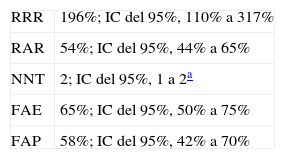El trabajo demuestra que una intervención educativa en las aulas, realizada por un fisioterapeuta, reduce el peso de las mochilas que deben transportar los escolares de 8 a 10 años. Conseguir que el peso de la mochila no supere el 10-15% del peso total del alumno evita la sobrecarga de la columna vertebral y, por tanto, uno de los factores de riesgo de presentar vertebrales. Cargas superiores modifican la curvatura espinal con una percepción de aumento de esfuerzo y aparición de dolor.
Material y métodoDiseño: tipo ensayo clínico controlado aleatorizado abierto. Emplazamiento: colegios públicos de Alcobendas y San Sebastián de los Reyes. Participantes: un total de 357 niños entre 8 y 10 años. Mediciones principales: se pesaron los niños y las mochilas escolares antes de la intervención educativa, inmediatamente después y a los 3 meses de la intervención educativa.
ResultadosRespecto de la variable principal del estudio, peso medio de la mochila, la diferencia entre los 2 grupos es superior a 1kg (diferencia señalada como relevante) tanto al acabar la intervención (diferencia de medias (DM)=2,28 kg) como a los 3 meses de la misma (DM=2,24kg), (p=<0,001) en ambos casos.
Respecto de la variable «peso excesivo en la mochila», observamos que los niños que recibieron la intervención tienen aproximadamente 3 veces más posibilidades, tanto al terminar dicha intervención como a los 3 meses (RR=2,63 y RR=2,96, respectivamente), de conseguir tener mochilas sin peso excesivo.
ConclusionesEl estudio demuestra que una intervención educativa con revisión del material escolar que transportan los estudiantes de 8 a 10 años consigue una disminución de más de 1 kg del peso de sus mochilas con respecto del grupo control (medias de 2,28kg al finalizar la primera intervención). Además, demuestra que estos resultados se mantienen en el tiempo (media de 2,24kg a los 3 meses).
This work shows that classroom educational orientation provided by a physiotherapist can lead to reduction in the weight of backpacks carried by 8-10 year old schoolchildren. The purpose was to have them limit backpack weight to no more than 10-15% of the total weight of the student and avoid some of the spinal cord overload and therefore one of the risk factors of suffering back pain. Higher loads can change spinal curvature with a perception of increased effort and onset of pain.
Materials and methodDesign: randomized, open labeled, controlled clinical trial. Location: public schools in Alcobendas and San Sebastian de los Reyes. Participants: a total of 357 children, aged 8 to 10 years. Main measurements: children and their school backpacks were weighed prior to the educational intervention, immediately after and at three months of the educational intervention.
ResultsRegarding the study primary endpoint, average weight of the backpack, the difference between the two groups was greater than 1kg (difference considered relevant) both at the end of the intervention (difference of means (SD)=2.28kg) and at 3 months of it (SD=2.24kg) (P=<.001). Regarding the endpoint “excess weight in the backpack”, it was observed that those children who received the intervention had approximately three times more likelihood both at the end of said intervention and at 3 months (RR=2.63 and RR=2.96, respectively) of carrying backpacks without excessive weight.
ConclusionsThe study shows educational intervention with review of school supplies transported by students aged 8 to 10 achieves a decrease of more than onekg in weight of their backpacks versus the control group (mean 2.28kg at the end of the first intervention). It also shows that these results are maintained over time (mean 2.24kg at 3 months).
Artículo
Si ya tiene sus datos de acceso, clique aquí.
Si olvidó su clave de acceso puede recuperarla clicando aquí y seleccionando la opción "He olvidado mi contraseña".Comprando el artículo el PDF del mismo podrá ser descargado
Precio 19,34 €
Comprar ahora













